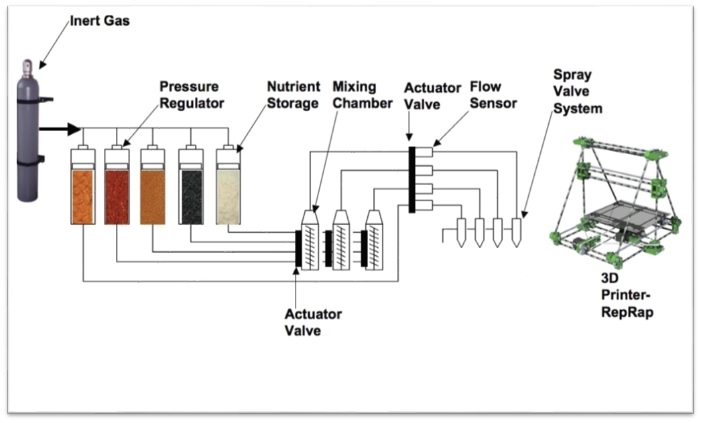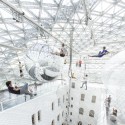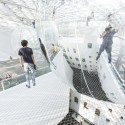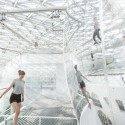Friday, June 28. 2013
"In Orbit" Installation / Tomįs Saraceno
Via ArchDaily
-----
A gigantic installation work by Tomás Saraceno, entitled “in orbit,” was just assembled last week in the Kunstsammlung Nordrhein-Westfalen in Germany. At a height of more than 20 meters above the piazza of the K21 Ständehaus, Saraceno has suspended a net construction within which visitors can move, apparently weightlessly. Saraceno’s net construction, which is accessible on three levels, resembles a cloud landscape: those bold enough to clamber high into the web set beneath the glass cupola perceive the museum visitors far below them from the lofty heights as tiny figures in a model world. The installation will be up until September 7th.
Studio Tomás Saraceno © 2013
“To describe the work means to describe the people who use it – and their emotions,” explains Tomás Saraceno concerning his largest installation to date, planned over the past three years in collaboration with engineers, architects, and arachnologists – experts on spiders and spider webs.
Studio Tomás Saraceno © 2013
This highly contemporary safety net, which covers altogether 2500 m², spreads itself out across three levels below the massive glass cupola of the K21 and the levels are held apart from one another by a series of “spheres,” airfilled PVC balls measuring up to 8.5 meters in diameter.
Studio Tomás Saraceno © 2013
Viewed from below or from intermediate levels of the Ständehaus, and against the background of the glass cupola, conversely, the people enmeshed in this net seem to be swimming in the sky. For the artist, this floating space becomes an oscillating network of relationships, neural pathways, resonances, and synchronous communication – a new digital geography, one that is experienced in physical terms.
Studio Tomás Saraceno © 2013
The various materials underscore Saraceno’s basic ideas of flow and lightness: “When I look at the multilayered levels of diaphanous lines and spheres, I am reminded of models of the universe that depict the forces of gravity and planetary bodies. For me, the work visualizes the space-time continuum, the three-dimensional web of a spider, the ramifications of tissue in the brain, dark matter, or the structure of the universe. With ‘in orbit,’ proportions enter into new relationships; human bodies become planets, molecules, or social black holes.”
Studio Tomás Saraceno © 2013
“in orbit” is one of the lightest projects realized by the artist to date: the work summons associations with the fineness and the stability of spider’s webs and soap bubbles – despite the fact that the net structure alone weighs 3000 kg, and the largest of the “spheres” weighs 300 kg. The conjunction of functionality, beauty, and strength that Saraceno has encountered during years of studying the web constructions of various spider species is also in evidence in the details of “in orbit.
Studio Tomás Saraceno © 2013
The precise observation of nature and the conceptual development of its phenomena are consistent trademarks of Saraceno’s work, which dissolves the boundaries between art and science. In this installation, space is perceived through vibration – just as it is by spiders. The result is a new, hybrid form of communication.
Studio Tomás Saraceno © 2013
Says the artist: “Each individual strand not only holds visitors in place, but weaves them into itself, at the same time allowing them to act. It is like an outstretched network with an open character. An open, cosmic, woven structure that becomes densified, ramified, before flowing out into lines again at its edges. The web is singular in its relationship to the existing architecture.”
For more information on the exhibition, please visit here.
Related Links:
Personal comment:
Following its previous installation (Quantum Physica) at Biocca in Milan, a new "cloud" architecture/installation by Seraceno in Germany.
Wednesday, June 26. 2013
Ant architecture
Following my previous post mentioning the printing of insects based food, could we also start to ask ants to design our own buildings?
Via Archinect
-----

Personal comment:
Not a friendly way to map the ant's constructions, but quite fascinating resulting metallic structures nonetheless. Something in between a bioinspired design, an amorphous (alien) organisation and a structrured, repetitive architectural pattern.
The audacious plan to end hunger with 3-D printed food
Via Computed·Blg via Quartz
-----
Anjan Contractor’s 3D food printer might evoke visions of the “replicator” popularized in Star Trek, from which Captain Picard was constantly interrupting himself to order tea. And indeed Contractor’s company, Systems & Materials Research Corporation, just got a six month, $125,000 grant from NASA to create a prototype of his universal food synthesizer.
But Contractor, a mechanical engineer with a background in 3D printing, envisions a much more mundane—and ultimately more important—use for the technology. He sees a day when every kitchen has a 3D printer, and the earth’s 12 billion people feed themselves customized, nutritionally-appropriate meals synthesized one layer at a time, from cartridges of powder and oils they buy at the corner grocery store. Contractor’s vision would mean the end of food waste, because the powder his system will use is shelf-stable for up to 30 years, so that each cartridge, whether it contains sugars, complex carbohydrates, protein or some other basic building block, would be fully exhausted before being returned to the store.
Ubiquitous food synthesizers would also create new ways of producing the basic calories on which we all rely. Since a powder is a powder, the inputs could be anything that contain the right organic molecules. We already know that eating meat is environmentally unsustainable, so why not get all our protein from insects?
If eating something spat out by the same kind of 3D printers that are currently being used to make everything from jet engine parts to fine art doesn’t sound too appetizing, that’s only because you can currently afford the good stuff, says Contractor. That might not be the case once the world’s population reaches its peak size, probably sometime near the end of this century.
“I think, and many economists think, that current food systems can’t supply 12 billion people sufficiently,” says Contractor. “So we eventually have to change our perception of what we see as food.”
There will be pizza on Mars

The ultimate in molecular gastronomy. (Schematic of SMRC’s 3D printer for food.)SMRC
If Contractor’s utopian-dystopian vision of the future of food ever comes to pass, it will be an argument for why space research isn’t a complete waste of money. His initial grant from NASA, under its Small Business Innovation Research program, is for a system that can print food for astronauts on very long space missions. For example, all the way to Mars.
“Long distance space travel requires 15-plus years of shelf life,” says Contractor. “The way we are working on it is, all the carbs, proteins and macro and micro nutrients are in powder form. We take moisture out, and in that form it will last maybe 30 years.”
Pizza is an obvious candidate for 3D printing because it can be printed in distinct layers, so it only requires the print head to extrude one substance at a time. Contractor’s “pizza printer” is still at the conceptual stage, and he will begin building it within two weeks. It works by first “printing” a layer of dough, which is baked at the same time it’s printed, by a heated plate at the bottom of the printer. Then it lays down a tomato base, “which is also stored in a powdered form, and then mixed with water and oil,” says Contractor.
Finally, the pizza is topped with the delicious-sounding “protein layer,” which could come from any source, including animals, milk or plants.
The prototype for Contractor’s pizza printer (captured in a video, above) which helped him earn a grant from NASA, was a simple chocolate printer. It’s not much to look at, nor is it the first of its kind, but at least it’s a proof of concept.
Replacing cookbooks with open-source recipes

SMRC’s prototype 3D food printer will be based on open-source hardware from the RepRap project.RepRap
Remember grandma’s treasure box of recipes written in pencil on yellowing note cards? In the future, we’ll all be able to trade recipes directly, as software. Each recipe will be a set of instructions that tells the printer which cartridge of powder to mix with which liquids, and at what rate and how it should be sprayed, one layer at time.
This will be possible because Contractor plans to keep the software portion of his 3D printer entirely open-source, so that anyone can look at its code, take it apart, understand it, and tweak recipes to fit. It would of course be possible for people to trade recipes even if this printer were proprietary—imagine something like an app store, but for recipes—but Contractor believes that by keeping his software open source, it will be even more likely that people will find creative uses for his hardware. His prototype 3D food printer also happens to be based on a piece of open-source hardware, the second-generation RepRap 3D printer.
“One of the major advantage of a 3D printer is that it provides personalized nutrition,” says Contractor. “If you’re male, female, someone is sick—they all have different dietary needs. If you can program your needs into a 3D printer, it can print exactly the nutrients that person requires.”
Replacing farms with sources of environmentally-appropriate calories

2032: Delicious Uncle Sam’s Meal Cubes are laser-sintered from granulated mealworms; part of this healthy breakfast.TNO Research
Contractor is agnostic about the source of the food-based powders his system uses. One vision of how 3D printing could make it possible to turn just about any food-like starting material into an edible meal was outlined by TNO Research, the think tank of TNO, a Dutch holding company that owns a number of technology firms.
In TNO’s vision of a future of 3D printed meals, “alternative ingredients” for food include:
- algae
- duckweed
- grass
- lupine seeds
- beet leafs
- insects
From astronauts to emerging markets
While Contractor and his team are initially focusing on applications for long-distance space travel, his eventual goal is to turn his system for 3D printing food into a design that can be licensed to someone who wants to turn it into a business. His company has been “quite successful in doing that in the past,” and has created both a gadget that uses microwaves to evaluate the structural integrity of aircraft panels and a kind of metal screw that coats itself with protective sealant once it’s drilled into a sheet of metal.
Since Contractor’s 3D food printer doesn’t even exist in prototype form, it’s too early to address questions of cost or the healthiness (or not) of the food it produces. But let’s hope the algae and cricket pizza turns out to be tastier than it sounds.
Related Links:
Personal comment:
It looks like cats and dogs are already eating "rapid prototyped" food --from what I see on the pictures here-- and are a step forward in the future from us! ;)
But would it be given to Adrią Ferran, it could start to look and taste like something!
But we could also put this in perspective with the recommendation from UN (Food & Agriculture) that humanity should eat more insects in the future, both because it needs less energy and produces less carbon dioxide to produce 1kg of insects (2kg of food produce 1 kg of insects while 20kg produce 1kg of meat...) and because they provide good and healthy nutriments. As many people still don't like to eat insects due to their aspect, turn them into powder and print them might be an interesting way.
Tuesday, June 25. 2013
China Plans to Move 250 Million into Cities by 2025
Via ArchDaily via The New York Times
-----
Li Rui, 60, scavenging his former village for building materials in Liaocheng. © Justin Jin for The New York Times
The old buildings under these high-rises in Chongqing have been marked for demolition. © Justin Jin for The New York Times
The Chinese government is pushing forward with a plan that will move 250 million Chinese people from rural communities into newly constructed towns and cities over the next 12 years. The government has been bulldozing ancient villages, temples and open-air theaters as well as paving over farmland to make way for mega-cities that will raise the number of city-dwellers in China to nearly the total urban population of the US.
For decades, the Chinese Communist Party insisted that peasants, even those working in cities, be tied to plots of land in order to ensure political and economic stability. Today, however, with the threat of a slowing economy, the party has reversed its stance, hoping to find new sources of national growth. China is looking for a way to restructure its economy, to become more independent, and rely less of exportation.
Their solution: domestic consumerism.
Urbanization and Level of Income. Courtesy of The New York Times
Those who live in rural communities in China are largely self-sufficient, living off of the land and requiring very little in terms of infrastructure and transportation. By pushing for rapid urbanization and a radical shift from production to consumption, the government believes that there will be countless new opportunities for construction companies, transportation, utilities and appliance makers. “If half of China’s population starts consuming, growth is inevitable,” said Li Xiangyang, vice director of the Institute of World Economics and Politics, part of a government research institute. “Right now they are living in rural areas where they do not consume.”
But this extreme approach to urbanization and modernization can be a dangerous one. In countries such as Brazil and Mexico, where urbanization was also seen as the vehicle for economic growth, slums expanded and unemployment clung to the newly relocated underclass. If China wants to succeed in its endeavor, it will need funds sufficient for the construction of new roads, hospitals, schools and community centers – which alone could cost more than $600 billion a year – as well as provide for education, health care and the pensions of ex-farmers. They will have to coordinate intensely among various ministries and somehow balance the rights of those dislocated by their policies.
Some of the people moved from their farmland to a housing project in Chongqing dance outdoors, the sort of recreation they never had time for as farmers. © Justin Jin for The New York Times
At his inaugural news conference, the country’s new prime minister, Li Keqiang, cautioned that it would require quite a few legal changes “to overcome various problems in the course of urbanization.” These could include chronic urban unemployment if jobs are unavailable, more protests from uncooperative farmers, a permanent underclass in big Chinese cities and the destruction of rural culture and religion – not to mention the obliteration (already taking place) of the traditional, organic Chinese city.
The day after Chinese architect Wang Shu received the Pritzker Prize in May of 2012, he returned to the old Beijing neighborhood where he had grown up only to find it in the process of being demolished. This neighborhood – called a “hutong” – was a maze of narrow streets and traditional courtyard houses that once characterized the urban fabric of a Chinese city; now, however, they are rapidly transforming into sprawling, gridded mega-cities of identical skyscrapers – copy-cats of many modern cities in the West.
“Cities today have become far too large,” Wang said in an interview in April. “I’m really worried, because it’s happening too fast and we have already lost so much.”
While China’s intense urbanization has caused irreversible destruction to much of the country’s rich architectural and urban past, it has also created and continues to create countless opportunities for innovative design. With so many plans and projects waiting to be developed, it’s only natural that China is becoming more and more fascinating to the architecture world. But what price must be paid, what sacrifices made by 250 million lives for the China of the future?
Tell us your thoughts below, and for the original story, check out this excellent New York Times article.
References: NYTimes, Bloomberg
Personal comment:
Hmmm? Consumerism?
I believe we've already tried that one, don't we?
Wednesday, June 19. 2013
An Interplanetary GPS Using Pulsar Signals
-----
Spacecraft could determine their position anywhere in the solar system to within five kilometres using signals from x-ray pulsars, say astronomers.

Navigating in space is a tricky business. The usual method relies on Earth-based tracking stations to work out a spacecraft’s distance using radio waves, a process that is accurate to within a metre or so.
That’s fine for the radial distance, but tracking a spacecraft’s angular position is much harder because of the limited angular resolution of radio antennas. The current technology produces an uncertainty of about four kilometres per astronomical unit of distance between Earth and the spacecraft.
So for a spacecraft at the distance of Pluto, that’s an uncertainty of 200 kilometres and at the distance of Voyager 1, the uncertainty is 500 kilometres.
So a way for spacecraft to determine their own position accurately would clearly be useful.
Today, Werner Becker at the Max Planck Institute for Radio Astronomy in Germany and a couple of pals have worked out the practical details for an autonomous spacecraft navigation system using pulsars signals. They say that technology being developed now would allow spacecraft to work out their position to within five kilometres anywhere in the solar system.
The idea of using pulsars to navigate in space dates back several decades. But Becker and co say previous analyses have been hampered by a limited knowledge of pulsars and the relatively bulky technology that has been available to detect them. Both of those things have changed dramatically in recent years.
First, the number of known pulses is growing significantly. Astronomers are aware of well over 2,000 pulsars and the next generation of radio observatories are expected to reveal tens of thousands more.
The basic idea behind this interplanetary navigation system is to use the signals from these pulsars in essentially the same way that we use GPS satellites to navigate on Earth. By measuring the arrival time of pulses from at least three different pulsars and comparing this with their predicted arrival time, it is possible to work out a position in three-dimensional space.
(Since pulsars produce a stream of identical pulses, it is possible to generate any number of ambiguous solutions when doing this. But Becker and co point out that these can be eliminated by constraining the solutions to a finite volume around the assumed position.)
The feasibility of such a system depends on a number of important practical factors, largely determined by the wavelength of the pulsar radiation that the navigation system is designed to detect. This determines the antenna collecting area, the power consumption, the weight of the navigation system, and of course its cost.
Becker and co calculate that for 21-centimeter waves, the spacecraft would require an antenna with a collecting area of 150 square meters.
But a better idea, they say, is to use pulsars that emit x-rays since the technology for collecting and focusing x-rays has improved dramatically in recent years.
One measure of the performance of x-ray mirrors is their mass. The mirror used on the Chandra X-ray Observatory launched in 1999 had a mass of 18.5 tonnes per square metre of effective collecting area. By comparison, the state-of-the-art glass micropore optics being made today have a mass of only 25 kilograms for the same collecting area.
So x-ray optics make good sense for pulsar navigation, say Becker and co. “Using the X-ray signals from millisecond pulsars we estimated that navigation would be possible with an accuracy of ±5 km in the solar system and beyond,” they say.
It may not be necessary to have this accuracy for most missions envisaged in the short term. However Becker and pals are optimistic about its future potential: “It is clear already today that this navigation technique will find its applications in future astronautics.” As they say, to infinity and beyond …
Ref: arxiv.org/abs/1305.4842: Autonomous Spacecraft Navigation With Pulsars
fabric | rblg
This blog is the survey website of fabric | ch - studio for architecture, interaction and research.
We curate and reblog articles, researches, writings, exhibitions and projects that we notice and find interesting during our everyday practice and readings.
Most articles concern the intertwined fields of architecture, territory, art, interaction design, thinking and science. From time to time, we also publish documentation about our own work and research, immersed among these related resources and inspirations.
This website is used by fabric | ch as archive, references and resources. It is shared with all those interested in the same topics as we are, in the hope that they will also find valuable references and content in it.


























